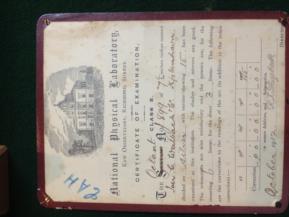
NavList:
A Community Devoted to the Preservation and Practice of Celestial Navigation and Other Methods of Traditional Wayfinding
From: Hewitt Schlereth
Date: 2014 Jan 21, 12:15 -0800
Hi Noell
This is consistent with what we have learned so far. I agree with Frank that its a *combination* of parameters
One parameter is resolution. It appears that it must resolve to better than or equal to 10". 10" was the statement found on the internet. 0.1 minutes is 6" so micrometer sextants will easily fulfill this requirement. Yours at 15" does not.
Another appears to be accuracy. Frank thinks it to be 1'. We have a random internet memory from a Commonwealth Navy stating 30". Your zero-zero sextant passes this requirement.
So of the two requirements, it fails one. I expect this is like Frank says, it knocks you down a grade.
There will be other conditions that we don't know about yet. That is why I'm ever so hopeful that Dr. Dunn can help us with a complete list of requirements.
Perhaps other board members have NPL (or Kew Observatory) certificates and would be willing to share.
Brad
On Jan 21, 2014 2:37 PM, "Noell Wilson" <noell_wilson{at}southwire.com> wrote:This is just another data point.
Attached is the 1912 calibration sheet from Kew Observatory, preprinted "Class B", and stating 0'0" for all angles listed.
So - 0'0" is not the criteria.
This Weilbach vernier sextant has a minimum reading differential of 15" so maybe one vote for precise measurement capability - not necessarily accuracy.
It's not an octant as the sheet says. The arc goes to 120 degrees but the arm stops a few degrees shy of full scale. It's an almost-sextant.
Regards, Noell
----------------------------------------------------------------
NavList message boards and member settings: www.fer3.com/NavList
Members may optionally receive posts by email.
To cancel email delivery, send a message to NoMail[at]fer3.com
----------------------------------------------------------------
Attached File:
(Kew-Observatory-Calibration-.JPG: Open and save)







